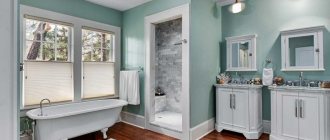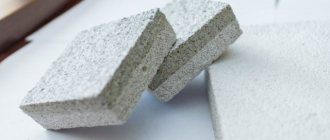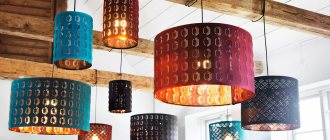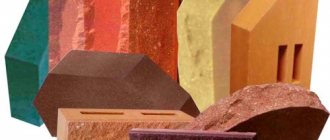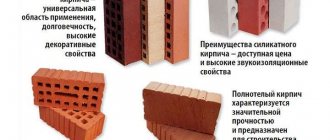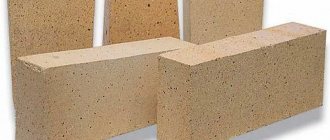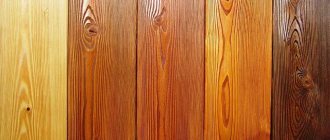How to cover decorative brick in an apartment?
In modern construction, artificial stone is widely used both for interior decoration and for external cladding of facades. This material looks very similar to natural stone and at the same time has many advantages.
Preparing the area and material for work:
Before laying gypsum tiles on the wall with your own hands, follow a number of steps:
- Clean the surface of the wall or other area from traces of previous decor and level it.
- Prime the wall with impregnation. It is also advisable to prime the stone itself. The primer will help reduce the absorption of the inner surface of the stone and remove dust. Let the primer dry.
- Start laying gypsum tiles by laying out several rows on the floor. Based on the resulting pattern, make markings and cut off the required pieces. Perform pruning with a hacksaw or grinder.
Surface markings:
To achieve perfect evenness of the masonry, use a building level or an electronic level. Don't forget to leave room for baseboards, floor coverings, etc.
Choosing adhesive for gypsum tiles:
The choice of adhesive for gypsum tiles depends on the installation method:
- With the seamless laying method, liquid nails, silicone sealant, polyurethane foam or other contact adhesives are applied pointwise in the middle of the tile.
- When laying decorative tiles under brick under jointing, use special gypsum glue or polymer putty, which are evenly applied to the entire surface to be decorated and to the tile.
- It is not advisable to use cement mortar. It takes longer to dry and during this time the plaster absorbs excess moisture. If you still use this glue, then you definitely need a priming step for high-quality installation.
Rules and subtleties of the gluing process:
Decide in what order you will lay the stone. If the stone is of different sizes, alternate large, medium and small tiles. In the second row, change the order. If the stone is the same size, then to start the second row, part of the stone needs to be sawed off with a hacksaw so that the seams of the top row do not coincide with the bottom.
In order for the corner to look beautiful, the tiles need to be cut using a miter box and a hacksaw at an angle of 45 degrees. Wall tiles are glued mainly horizontally. Gluing is done both from above and from below. Work starts from the corner. The edge of the furniture adjacent to the installation site is covered with masking tape. It is removed in small parts immediately after gluing two or three tiles, until the glue has dried. The nuances of installation depend on the chosen method:
- Seamless masonry. Before gluing gypsum tiles to the wall using this method, you need to check its geometry. Sometimes the dimensions of the parts differ from each other. In this case, the middle of the wall is laid out as perfectly as possible. After all, she is the one who always comes into view.
- Masonry for jointing without filling the seam. Often the seams are not filled, since gluing gypsum bricks to the wall using this method is cheaper and faster. The main difficulty is to apply the adhesive very evenly and thinly to the wall. Use a spatula without teeth for this. If the glue comes out from under the tiles, spread it evenly along the seam with a wet brush.
- Masonry for jointing with joint filling. The seam is filled with a mounting gun or a special bag for unstitching.
- To fill the joints, use a special grout for gypsum brick tiles. Dilute the powder according to the instructions, place it in a cone bag and fill all the seams. The width of the opening in the bag is less than or equal to the width of the seam. After application, leave to dry to the consistency of softened plasticine. Then use a special spatula to remove the excess. A relief characteristic of such masonry should be formed. After drying, clean the tiles with a medium-hard brush to remove grout residue. Treat the entire lined surface with polyurethane or acrylic varnish, or any moisture-repellent agent to create reliable waterproofing protection and ensure long-term operation.
Old marble
If you like the effect of aging, you can treat the product so that the material becomes similar to old marble.
The work is carried out in a certain order:
The purchased stone will need to be kept for two days in a dark room. If you created the product yourself, dry it thoroughly (maximum at 55 degrees). Warm up the drying oil
This should be done very carefully and you will need to use gloves when working. The material is applied using a flute brush. It is recommended to apply it in 2 layers
Try not to leave unimpregnated areas: the product should be processed evenly. After some time, the surface will look like old marble.
What paint should I use to coat gypsum tiles?
At home, you can carry out surface painting of gypsum bricks. For painting the following are used :
- Acrylic paint for plaster . You can buy it ready-made at a hardware store or paint it yourself. Together with a primer and water repellent, acrylic paint reliably protects against fungus, mold, and reduces water absorption.
- Silicate and silicone for painting external walls . It is based on liquid glass and silicone resins. It is characterized by the durability of the coating, service life is about 20 years.
- Water-soluble varnishes for matte or glossy surfaces. Varnishes provide reliable protection of the stone from abrasion.
After treating the surface with varnish, its original shade will become noticeably darker.
Read more about how to paint a plaster wall here.
No. 4. Criteria for choosing paintwork materials
The choice of the most suitable coating composition depends on the place of its application. When working with external walls, building facades and street structures (gazebos, fences), it is necessary to give preference to products with an increased level of moisture protection and resistance to UV rays. Also, such varnishes should look impressive on brickwork without losing their decorative functions during seasonal rainfall.
Other requirements are put forward for compositions for fireplaces and stoves:
- No toxicity. The varnish should not have an unpleasant odor, since when heated, dangerous toxins can be released.
- Heat resistance. For coatings of fireplace structures, only specialized compounds that are fire-resistant should be used.
To cover interior brick walls, it is better to give preference to acrylic or silicone compounds. The choice of such varnishes is large enough to choose the most profitable option.
Types of varnishes and their application
To improve the performance characteristics of gypsum tiles, they should be varnished. The following products are considered the most popular on the market and in construction stores:
- oil-based varnishes;
- yacht varnish for gypsum surface;
- protective acrylic coating.
Oil based varnish
The composition of oily varnishes includes a solution of artificial resins and a collection of plant herbs. The substance is brought to an oily consistency and combined with additional materials, which as a whole form a varnish. Due to its texture, the coating forms a thin film on the surface, which, after complete drying, protects the gypsum tile from physical and mechanical damage.
Oil varnishes can be transparent (colorless) and are also available in a variety of shades. Therefore, when purchasing, compare the color of the original material and its future coating. To give the surface different effects, you can purchase glossy or matte varnish. It should be noted that if you varnish (even colorless) a plaster surface, it may become slightly darker than it was originally.
When covering a wall decorated to look like stone, try to protect your body and face from getting paint and varnish. Wear protective clothing, gloves, goggles and a respirator, as the composition has a specific pungent odor.
On video: varnish for stone.
Acrylic composition
When purchasing varnish for gypsum tiles, most builders want to get a material that will combine “two in one” characteristics. That is, initially it is a protective coating, and only then performs a decorative function.
All desired requirements will be met if you cover the tiles with acrylic varnish. In construction stores or on the market you can purchase ready-to-use material, which, when applied to the surface, forms a durable thin film.
Acrylic varnish is a “protective shield” for artificial stone. It is moisture resistant, reflects UV rays, and is resistant to various detergent compositions and temperature changes. The material has no toxic odor, dries quickly, and if excess needs to be removed, this can be done using a special solvent. If the acrylic varnish is too thick in consistency, it can be diluted with plain water.
Acrylic coating is divided into three types:
- matte;
- semi-matte;
- glossy.
If you use matte acrylic varnish to cover the plaster, the imitation of rough stone will be preserved down to the smallest touch. After application, the composition penetrates into all existing cracks and recesses, and as it dries it takes on a transparent matte texture.
Semi-matte plaster varnish has similar characteristics to the previous material. The coating has only one drawback - after drying, you can notice a light light coating on the finish. Of course, if you choose a varnish that matches the tone of the tile, this effect can be avoided, but colorless compositions can present an unwanted surprise.
When choosing a glossy finish, keep in mind that in a brightly lit room the surface will be very shiny. Consequently, the interior decoration will be distorted due to glare.
If, according to the designer’s plan, the gypsum tile will be painted with water-based paint, then for better adhesion of the material to the surface, add acrylic varnish to the solution. The paint should be applied with two salts, and after complete drying, open with one layer of varnish.
Manufacturers
We bring to your attention the best manufacturers of brick varnishes. The products of these companies demonstrate the ability to withstand high temperatures, precipitation, UV rays and various chemical reagents.
Let’s conditionally put the German brand “Pufas” in first place. This is one of the oldest concerns in the world market of paints and varnishes; today its product range includes over 200 types of finishing materials.
Among the foreign ones, the American one stands out. Among our consumers, varnishes and impregnations for brickwork that create a “wet stone” effect are especially popular.
Speaking about Russian companies specializing in the production of paints and varnishes, let us mention the Neomid STONE trademark (also known under the Neomid brand). Among the required qualities of varnishes and impregnations, we highlight the following:
- Branded matte and semi-matte coating effects.
- Increased protection against moisture.
- Antifungal additives.
I would also like to note that all Neomid STONE products have no toxic odor, which makes them suitable for interior finishing work.
Another domestic manufacturer worthy of mention is. It specializes in the production of heat-resistant varnishes for treating brickwork of stoves, fireplaces, and fireboxes.
And our TOP 5 manufacturers of high-quality paints and varnishes completes. To protect the brick surface, several types of coatings are produced, including “Protexil” and “Epoxol”, as well as “Aquastone” and “Texil”.
Let us note that the above-mentioned Russian companies produce their products based on imported raw materials from such famous and others.
Additional finishing of gypsum brick
Gypsum bricks used in the interior can be additionally decorated in the desired color, if this was not done at the production stage. Most often, the consumer prefers to use decorative cladding with ready-made shades that imitate old stone or rock bricks. But what if the tiles were purchased in semi-finished format, that is, white? In this case, you can decide on the decoration issue yourself. The following mixtures are used as coloring matter:
- Water-based paint of the desired shade. Moreover, you can simply roll the entire surface of the finish with a roller, or you can leave gaps and highlights on the surface of the stone. This activity is quite tedious, but the creative process gives rise to individuality.
- Coloring impregnation for concrete products. This mixture does not require additional protection from above and goes on smoothly and quickly.
- Water-soluble varnish is used as a protective coating for gypsum bricks. Such a thin film will not only protect the shade of the tile from abrasion, but will also provide the ability to wet clean the brick panel or cladding.
- Glaze. Also used to create a protective layer on the surface of brick tiles.
No. 5 Recommendations for applying varnish to a brick base
When deciding to use coatings to protect and decorate brick walls, it is important to remember that in order to obtain the desired results, you should not only choose the most effective product, but also observe all the details of the coating.
Varnish can be applied to walls in various ways: using a brush, roller or spray gun. Manufacturers insist that the composition should be applied in several layers (at least two). In addition, it is important to follow several important recommendations:
- The varnish should be applied at a temperature not lower than 10 and not higher than 30 degrees.
- Each applied layer requires time to absorb and dry.
- It is possible to coat a brick base with varnish only after preliminary treatment of the material.
Interior ideas
When choosing a brick finish to decorate a particular interior, it is important to choose the right area, as well as the color of the material, which will optimally suit the palette of the interior and furniture. Let's take a closer look at how to organize the decoration of different rooms with decorative bricks.
Decorative brick in the living room
This is a special room in the apartment that requires a careful approach to decoration - after all, this is where festive events with friends and relatives and family gatherings will be held. In newfangled interiors, you can often find living room designs with an emphasis on brick walls. It is worth noting that the masonry itself is an excellent decorative element that does not require additional decorations. If desired, you can display a gallery of family photographs, a display of artwork or posters on a brick wall.
You can choose any color of brick in the living room - the main thing is that it is in harmony with the interior. In this way you can decorate one of the walls or individual sections. The decoration of the room will be a brick fireplace or a niche in the wall, creating a special atmosphere of comfort. If the living room is combined with a kitchen, a good option would be a small brick wall that acts as a zone divider.
Decorative brick in the bedroom
Considering the fact that brick looks quite warm and attractive, it is perfect for decorating a bedroom. The material combines well with other types of cladding. Often, brickwork is used to decorate the wall at the head of the bed or the one on which the television panel is installed. If the bedroom is narrow and the bed is located with its back side to the long wall, it is this wall that is decorated with brick. This technique helps to visually move the wall away and expand the room.
Decorative brick in the hallway
In small corridor spaces, white decorative brick with a glossy surface will look best. This design will help increase the area and make the space freer, which is typical for modern minimalism, as well as the Scandinavian style.
It is better to decorate with red brick in fragments, decorating in this way corner areas, areas at the junctions of walls, arched areas and doorways. Masonry can take part in zoning a spacious hallway.
Decorative brick in the kitchen
The kitchen, even if it is quite spacious, is not recommended to be completely covered in brick, so as not to end up with a basement interior. It is much better to use masonry as a link between different types of finishes. Determining the wall where the brick will be located occurs according to the following principle: where natural light falls, there is a place for masonry. For a wall made of red brick, which has the ability to absorb light, it is better to consider additional lighting.
Since the hygroscopicity of the material does not allow it to be used as an apron, here you can use imitation cladding - PVC panels or brick-like tiles.
Decorative brick in the bathroom
The bathroom has a specific microclimate, and decorative brick is not the best option for cladding. In extreme cases, the masonry will need to be coated with agents that prevent the formation of mold, as well as antibacterial compounds.
From an aesthetic point of view, the combination of the rough surface of decorative bricks with snow-white plumbing fixtures has a very attractive appearance. Instead of brickwork, moisture-resistant wallpaper, tiles or plastic panels that imitate it are also used in bathrooms.
vote
Article rating
Preparation for painting: important requirements
When carrying out work on painting the surface, it is worth considering that brick is a porous material. To completely dry and weather the wall, the house must stand for a long time in its original form.
For external work
When choosing to paint an external brick wall, you should consider the following points:
It is not advisable to paint fresh masonry. The surface must fully go through the stages of drying, weathering and leaching. This may take a year. Before painting, prepare the wall surface; it must be clean. What color should I paint the decorative plaster in the hallway? To do this, remove salt stains, wash with soapy water and allow to dry thoroughly. Excess moisture will evaporate from the surface within a week. Painting brickwork creates a modern and trendy home style
Attention is diverted from small defects in the walls. You can choose a paint color that matches other buildings on the site.
For interior work
Large and clearly visible imperfections are better to be filled or plastered. Although the brickwork should be rough with a surface without large cracks or chips, it is easier to paint this way, and the wall looks neater.
The surface should be carefully primed. Choose a deep penetration primer that creates a dense water-repellent film.
Brick, as a building material, is not entirely suitable for painting. This is due to its porous structure. In the future, removing paint from it and plastering the surface will be quite problematic.
The only option is to repaint the wall a different color.
We paint the product “to look like stone”
A short lesson in painting like a stone.
We are not interested in painting to look like brick or just rubble stone. The question is how to paint specifically for decorative stone, marble, jasper, malachite, and so on. This algorithm and sequence is the basis of the direction. By understanding and trying, you can learn to imitate different options and textures.
What we need for painting: 1) Brushes 001, 1,2 2) A sponge, or a piece of foam rubber, or a toothbrush 3) Acrylic or oil paints, whichever you prefer. Oil paints allow for deep, layered textures and require more experience working with paints. For a beginner, you can start with acrylic or practice on paper with simple watercolors. 4) Well, actually, what are we going to describe?
1) Step one
We apply matte white primer to the product we need. Then we apply the first primary color, which we will use for painting. In our case it is black.
2) Step two
Using a sponge, a piece of foam rubber or a toothbrush, apply the first texture. The color of the texture depends on what we want to get in the end. To imitate jasper, you can use white, gray and purple colors, applying them one after another. In our case, we will use two colors: light green (pale green) and light green (variations and color shades of green can be any, do not be afraid to experiment with color). Apply the first layer and let it dry. When using acrylic paints, this will take 10-15 minutes.
3) Step three
After the prepared base has dried, we begin to draw lines. It is advisable to draw lines with brushes of varying fineness from 001 to 2 (brush size). Direction, discontinuity, thickness of lines - it all depends on your imagination. To make it easier, imagine that you are drawing lightning breaks
The color of the lines also depends on what stone you are imitating. In our case, we mix a little green into the white color and draw lightning.
After complete drying, we apply a layer of glossy varnish.
An example of painting under “gray marble”.
A small, as they say now, life hack
If you have no desire to paint the surface like a stone, then you can create an imitation of the structure of an ornamental stone by simply mixing two different colors of polymer clay
I hope the lesson was interesting and instructive. I invite you to visit my page and see my work.
Advantages of gypsum
Various building mixtures are made based on gypsum, both for interior and exterior use. Dry gypsum is added to many putties, plasters and glues as an excellent binding component. This material is added to many finishing and building materials because it has the following advantages:
- external attractiveness;
- low weight, which is combined with high strength;
- creates effective insulation of heat and noise;
- it can be used to make attractive, unique products for interior and exterior decoration;
- environmentally friendly and safe material for human health;
- fungi and mold do not settle on it;
- is a vapor-permeable, breathable material;
- very easy to process, it can be applied to any type of surface;
- With the help of accessible, extraordinary tools, you can easily change the shape of gypsum products.
Why paint a brick wall?
Artificial ceramic stone is a popular material for construction work. For the construction of walls, ordinary brick is used, the surface of which is rough and unattractive. When choosing masonry as a decorative element, it is necessary to improve the aesthetic perception of the surface. Painting brick white looks great in rooms decorated in loft, modern, and high-tech styles. The characteristic relief of the walls is preserved, but its presentability is enhanced.
Photo 1. Painting bricks white makes the room brighter
Brick facades of buildings are painted for various reasons:
- As a result of long-term use, the original appearance has been lost.
- The masonry has partially collapsed; repairs require plastering and color restoration.
- Construction of extensions where the creation of an overall harmonious composition is required.
- The desire to change the decorative appearance of the structure is also a powerful argument (photo 2).
Photo 2. Changing the decorative appearance of the facade by painting
